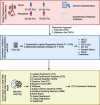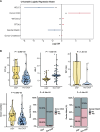An integrated machine learning model enhances delayed graft function prediction in pediatric renal transplantation from deceased donors
- PMID: 39304842
- PMCID: PMC11415997
- DOI: 10.1186/s12916-024-03624-4
An integrated machine learning model enhances delayed graft function prediction in pediatric renal transplantation from deceased donors
Abstract
Background: Kidney transplantation is the optimal renal replacement therapy for children with end-stage renal disease; however, delayed graft function (DGF), a common post-operative complication, may negatively impact the long-term outcomes of both the graft and the pediatric recipient. However, there is limited research on DGF in pediatric kidney transplant recipients. This study aims to develop a predictive model for the risk of DGF occurrence after pediatric kidney transplantation by integrating donor and recipient characteristics and utilizing machine learning algorithms, ultimately providing guidance for clinical decision-making.
Methods: This single-center retrospective cohort study includes all recipients under 18 years of age who underwent single-donor kidney transplantation at our hospital between 2016 and 2023, along with their corresponding donors. Demographic, clinical, and laboratory examination data were collected from both donors and recipients. Univariate logistic regression models and differential analysis were employed to identify features associated with DGF. Subsequently, a risk score for predicting DGF occurrence (DGF-RS) was constructed based on machine learning combinations. Model performance was evaluated using the receiver operating characteristic curves, decision curve analysis (DCA), and other methods.
Results: The study included a total of 140 pediatric kidney transplant recipients, among whom 37 (26.4%) developed DGF. Univariate analysis revealed that high-density lipoprotein cholesterol (HDLC), donor after circulatory death (DCD), warm ischemia time (WIT), cold ischemia time (CIT), gender match, and donor creatinine were significantly associated with DGF (P < 0.05). Based on these six features, the random forest model (mtry = 5, 75%p) exhibited the best predictive performance among 97 machine learning models, with the area under the curve values reaching 0.983, 1, and 0.905 for the entire cohort, training set, and validation set, respectively. This model significantly outperformed single indicators. The DCA curve confirmed the clinical utility of this model.
Conclusions: In this study, we developed a machine learning-based predictive model for DGF following pediatric kidney transplantation, termed DGF-RS, which integrates both donor and recipient characteristics. The model demonstrated excellent predictive accuracy and provides essential guidance for clinical decision-making. These findings contribute to our understanding of the pathogenesis of DGF.
Keywords: DGF; Delayed graft function; Machine learning; Pediatric kidney transplantation; Predict.
© 2024. The Author(s).
Conflict of interest statement
The authors declare no competing interests.
Figures




References
-
- Cesca E, Ghirardo G, Kiblawi R, Murer L, Gamba P, Zanon GF. Delayed graft function in pediatric deceased donor kidney transplantation: donor-related risk factors and impact on two-yr graft function and survival: a single-center analysis. Pediatr Transplant. 2014;18(4):357–62. - PubMed
-
- Perico N, Cattaneo D, Sayegh MH, Remuzzi G. Delayed graft function in kidney transplantation. Lancet (London, England). 2004;364(9447):1814–27. - PubMed
-
- Ponticelli C. Ischaemia-reperfusion injury: a major protagonist in kidney transplantation. Nephrology, Dialysis, Transplantation: Official Publication of the European Dialysis and Transplant Association - European Renal Association. 2014;29(6):1134–40. - PubMed
-
- Tejani AH, Sullivan EK, Alexander SR, Fine RN, Harmon WE, Kohaut EC. Predictive factors for delayed graft function (DGF) and its impact on renal graft survival in children: a report of the North American Pediatric Renal Transplant Cooperative Study (NAPRTCS). Pediatr Transplant. 1999;3(4):293–300. - PubMed
Publication types
MeSH terms
Grants and funding
LinkOut - more resources
Full Text Sources
Medical

